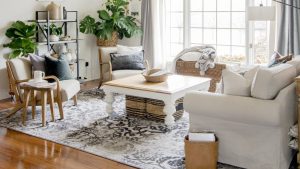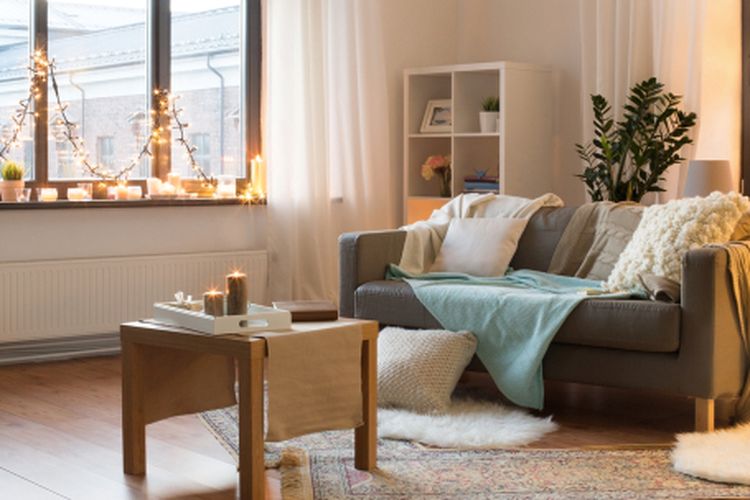Introduction
The living room is the heart of the home, where family and friends gather to relax, socialize, and unwind. A well-designed living room should feel warm, inviting, and comfortable, making everyone feel at home. Whether you prefer a modern, rustic, or classic style, creating a cozy atmosphere is all about choosing the right elements, from furniture to lighting and textures.
In this guide, we will explore practical tips to make your Living Room Feel More Inviting, helping you design a space that reflects your personality while offering comfort and warmth.
Choosing the Right Color Palette

1. Warm and Neutral Tones
The color scheme sets the mood of the living room. Warm and neutral tones create a cozy and welcoming feel. Colors like beige, soft greys, warm whites, and earth tones add warmth and sophistication.
- Soft neutrals make small spaces feel larger and brighter.
- Darker tones add depth and richness to the room.
- Accent colors like mustard, terracotta, or deep green enhance the coziness.
2. Adding Pops of Color
While neutral shades are ideal for a calming ambiance, adding pops of color brings personality to your space. Consider using:
- Throw pillows or blankets in rich hues.
- Artwork or decorative pieces that complement the overall theme.
- Rugs or curtains with subtle patterns to introduce color.
Furniture Arrangement for Comfort and Functionality

1. Choosing Comfortable Seating
Seating is the most important element in designing an inviting living room. Opt for plush sofas, sectionals, or armchairs that offer both comfort and style.
- Oversized couches provide a cozy feel for lounging.
- Accent chairs add elegance while offering additional seating.
- Ottomans and poufs can be used as footrests or extra seating.
2. Arranging Furniture for Conversation
The layout of your furniture plays a crucial role in how inviting the space feels. Arrange seating in a way that encourages conversation and interaction.
- Position the sofa and chairs facing each other rather than against the walls.
- Keep furniture within a comfortable distance to create an intimate setting.
- Use a coffee table or central rug to tie the arrangement together.
Incorporating Cozy Textures and Fabrics

1. Layering with Soft Textiles
Textures add warmth and comfort to any living room. Layering different materials can make the space feel more inviting.
- Plush throw blankets for added warmth in colder months.
- Velvet or knitted cushions for softness and coziness.
- Rugs with soft fibers, such as wool or shag, to add comfort underfoot.
2. Using Natural Materials
Incorporating wood, linen, and cotton makes the living room feel natural and cozy. Choose:
- Wooden furniture for warmth and rustic charm.
- Linen curtains to create an airy and relaxed atmosphere.
- Wicker baskets or rattan elements for added texture.
The Importance of Lighting

1. Layered Lighting for Ambiance
Lighting is essential for creating a warm and inviting atmosphere. Layering different types of lighting enhances coziness.
- Ambient lighting: Soft overhead lighting to brighten the room.
- Task lighting: Table lamps and reading lights for functionality.
- Accent lighting: String lights, candles, or LED strips for mood enhancement.
2. Using Warm Light Bulbs
Cool white lighting can make a room feel sterile, while warm light bulbs create a cozy and comfortable environment. Opt for:
- Soft yellow or warm white LED bulbs.
- Dimmer switches to adjust brightness according to the mood.
- Candles or lanterns to enhance the cozy factor.
Adding Personal Touches and Décor

1. Displaying Meaningful Decor
Personalized decor makes a Living Room Feel Like Home. Adding family photos, travel souvenirs, or sentimental pieces adds warmth and character.
- Gallery walls showcasing memories.
- Bookshelves with curated books and keepsakes.
- Artwork or sculptures that reflect your personality.
2. Bringing Nature Indoors
Plants enhance air quality and add a fresh touch to any space. Choose low-maintenance houseplants such as:
- Pothos or snake plants for easy care.
- Fiddle leaf fig or monstera for a bold statement.
- Herb gardens or succulents for small spaces.
Maximizing Space and Storage

1. Smart Storage Solutions
A clutter-free living room feels more inviting. Use functional storage solutions to keep the space organized.
- Hidden storage furniture like ottomans or storage benches.
- Floating shelves for decorative displays.
- Baskets and bins to store blankets and magazines.
2. Minimalist Approach for a Clean Look
A minimalist design can make the living room feel more spacious and relaxing. Keep only essential furniture and decor, and opt for multi-purpose items.
Table: Key Elements for a Cozy and Inviting Living Room
| Element | Description |
|---|---|
| Color Palette | Warm neutrals and accent colors add coziness. |
| Furniture Arrangement | Comfortable seating and a conversational layout enhance relaxation. |
| Textures & Fabrics | Layered textiles create warmth and depth. |
| Lighting | Soft, layered lighting makes the space feel inviting. |
| Personalized Decor | Family photos, artwork, and plants add character. |
| Storage Solutions | Hidden storage and minimal clutter improve functionality. |
Conclusion
Designing a cozy and inviting living room is about creating a space that feels warm, comfortable, and personal. By choosing the right colors, furniture, textures, and lighting, you can transform your living space into a relaxing haven for yourself and your guests.
Adding personal decor, natural elements, and smart storage solutions ensures your living room remains stylish yet functional. Start implementing small changes today, and enjoy a cozy and welcoming space that you’ll love spending time in.




